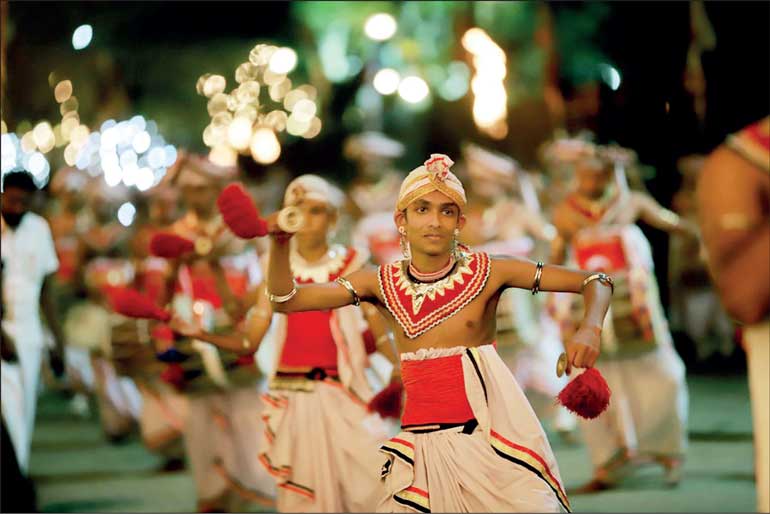Wednesday Jul 02, 2025
Wednesday Jul 02, 2025
Thursday, 30 May 2024 00:20 - - {{hitsCtrl.values.hits}}

Developing culturally-focused tour packages, along with collaboration with SAARC tourism bodies, can develop a sense of regional unity and attract a diverse range of visitors from within the region
 Sri Lanka’s tourism sector experienced a significant setback during the pandemic, due to travel restrictions and safety concerns. However, the country’s determined efforts to revive the sector have yielded remarkable results during the first quarter of 2024. Strategic tourism promotion campaigns, coupled with infrastructure improvements, have successfully attracted tourists back to the island nation.
Sri Lanka’s tourism sector experienced a significant setback during the pandemic, due to travel restrictions and safety concerns. However, the country’s determined efforts to revive the sector have yielded remarkable results during the first quarter of 2024. Strategic tourism promotion campaigns, coupled with infrastructure improvements, have successfully attracted tourists back to the island nation.
During the first quarter of 2024, Sri Lanka witnessed a near doubling of tourist arrivals compared to the same period in the previous year. Moreover, the country’s focus on managing and developing tourist attractions has further elevated its appeal. Sri Lanka’s welcoming visa policies, including visa-on-arrival options and streamlined e-visa processes, have also played a crucial role in attracting international visitors.
As a result of these combined efforts, Sri Lanka welcomed 0.65 million tourists in the first three months of 2024, accounting for an impressive 42% of the total visitors received throughout the entire previous year. This resurgence demonstrates the resilience and potential of Sri Lanka’s tourism industry, paving the way for a promising future.
Prior to the pandemic, Sri Lanka enjoyed a relatively stable exchange rate, with the Sri Lankan Rupee trading around 174 against the US Dollar, However, the post-pandemic economic crisis significantly impacted the currency, causing a sharp depreciation and reaching an all-time high of nearly Rs. 370 per dollar in May 2022. The Lankan economy was also crippled by a severe debt crisis and is showing signs of recovery. After experiencing a peak inflation rate of 70% in 2022, the country has witnessed a dramatic decline, with inflation dropping from 5.9% in February to 0.9% in March 2024.
Fortunately, as the tourism sector experiences a revival and the economy gradually recovers, the Lankan economy and exchange rate are showing signs of stabilisation, bringing renewed optimism for Sri Lanka’s economic future. This positive trend coincides with the economy’s return to growth in the latter half of the previous year, marking a turning point after a prolonged period of economic contraction that lasted for a year and a half.
The first quarter of 2024 saw 115,280 tourists from South Asia visit Sri Lanka, a notable increase compared to the 374,126 total visitors during the year 2023. If this trend continues, the year 2024 could witness a substantial surge in tourists arriving from South Asian countries. However, Sri Lanka is well connected and integrated with South Asian countries, with direct flights operating from Colombo to five countries in the region, unable to grasp the larger portion of tourism within the region except from India. India stands out as the largest contributor, with a staggering 96,279 tourists visiting Sri Lanka, signifying the strong travel ties between the two nations.
Maldives, Bangladesh and Pakistan also contribute, with 7,716, 6,026, and 3,196 tourists respectively. Nepal, Bhutan, and Afghanistan, with 1,442, 270, and 65 tourists respectively, show a smaller yet growing interest in Sri Lanka. However, geopolitical situations and economic factors likely play a role in limiting travel from these countries, highlighting the need for further efforts to improve accessibility and promote tourism exchange within the entire South Asian region.
To capture the immense potential of the 1.8 billion South Asian market, Sri Lanka needs a targeted approach to attracting regional tourists. Improving regional connectivity through increased flight routes and streamlined travel procedures. Developing culturally-focused tour packages, along with collaboration with SAARC tourism bodies, can develop a sense of regional unity and attract a diverse range of visitors from within the region.
The study ‘South Asia towards a greater regional air connectivity’ by SAARC Chamber of Commerce and Industry (SCCI) highlights a significant gap in regional air connectivity within South Asia, despite the progress made by countries like India and Sri Lanka. This presents a unique opportunity for Sri Lanka to take a leading role in addressing this challenge and reaping the benefits of increased regional tourism. By advocating for and implementing the study’s recommendations, such as open skies agreements, airline incentives, and code-sharing partnerships, Sri Lanka can position itself as a hub for regional travel, attracting airlines and tourists alike. This proactive approach would not only enhance Sri Lanka’s connectivity but also stimulate tourism growth, economic cooperation, and regional integration within South Asia, ultimately solidifying the nation status as a key player in the region tourism landscape.
Sri Lanka’s tourism industry has shown remarkable resilience and adaptability, bouncing back from the challenges posed by the pandemic and economic instability. The significant increase in tourist arrivals during the first quarter of 2024 demonstrates the potential for sustained growth. However, to fully capitalise on this momentum and establish itself as a premier tourist destination in the region, Sri Lanka must address existing challenges and strategically leverage its strengths.
Advocating for improved air connectivity, streamlined travel procedures, and joint tourism promotion initiatives, Sri Lanka can tap into the vast South Asian market and beyond to attract a more diverse range of visitors. Continued focus on infrastructure development, cultural preservation, and sustainable tourism practices will further enhance the country appeal and ensure a thriving tourism sector for years to come. As Sri Lanka embraces these opportunities and navigates the evolving global tourism landscape, it has the potential to become a shining example of a nation that successfully harnesses the potential of tourism for economic prosperity and cultural exchange.
(The writer is President, Federation of Chambers of Commerce and Industry of Sri Lanka, and EC Member, SAARC Chamber of Commerce and Industry.)
Discover Kapruka, the leading online shopping platform in Sri Lanka, where you can conveniently send Gifts and Flowers to your loved ones for any event including Valentine ’s Day. Explore a wide range of popular Shopping Categories on Kapruka, including Toys, Groceries, Electronics, Birthday Cakes, Fruits, Chocolates, Flower Bouquets, Clothing, Watches, Lingerie, Gift Sets and Jewellery. Also if you’re interested in selling with Kapruka, Partner Central by Kapruka is the best solution to start with. Moreover, through Kapruka Global Shop, you can also enjoy the convenience of purchasing products from renowned platforms like Amazon and eBay and have them delivered to Sri Lanka.
Discover Kapruka, the leading online shopping platform in Sri Lanka, where you can conveniently send Gifts and Flowers to your loved ones for any event including Valentine ’s Day. Explore a wide range of popular Shopping Categories on Kapruka, including Toys, Groceries, Electronics, Birthday Cakes, Fruits, Chocolates, Flower Bouquets, Clothing, Watches, Lingerie, Gift Sets and Jewellery. Also if you’re interested in selling with Kapruka, Partner Central by Kapruka is the best solution to start with. Moreover, through Kapruka Global Shop, you can also enjoy the convenience of purchasing products from renowned platforms like Amazon and eBay and have them delivered to Sri Lanka.